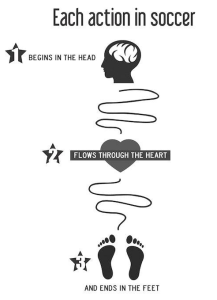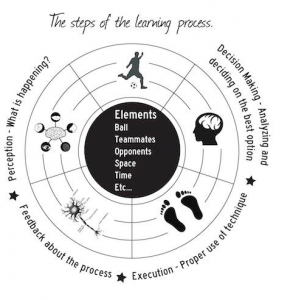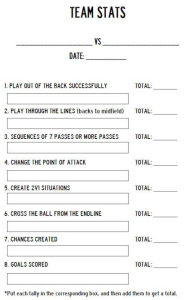What Really Matters in Youth Player Development
Up Close with Coach and Author Stan Baker
Stan Baker talks about warming up the spirit of youth soccer players and remembering the joy in player development. What’s Baker’s focus? Increasing a players’ ability to make intelligent decisions, not just improve their technique. Soccer starts in the head (perception and decision making), flows through the heart, (passion for the game) and ends in the feet (the execution or technique). We have placed so much emphasis on the feet that we have forgotten where it all needs to start.
Stan Baker has traveled extensively and was honored by US Youth Soccer as the 2011 Competitive Coach of the Year. Baker coaches U14 and U15 boys’ teams at West Side Timbers in Portland. He also coaches the Pre Academy 2000 Portland Timbers team. In addition to this, he is the author of Our Competition Is the World, a book on implementing the U.S. Soccer coaching curriculum that was recently reviewed in the Soccer Lover’s Best Ever Soccer Book Guide.
Diane Scavuzzo: What is the biggest challenge facing competitive coaches when training their youth soccer players?
Stan Baker: One of the greatest challenges is getting coaches to understand that they are creating an environment for the players. The development of the players depends on the type of environment we create. Wise coaches stimulate players and are aware that over coaching is detrimental to the player’s development.
Diane Scavuzzo: What do you mean by the word environment?
Stan Baker: It all starts with the proper numbers of players at training and games for the specific age group at practice. For example, 7-9 year olds should play in a 3v3 environment, 10-11 year olds in a 5v5 environment and U12 players should play in a 7v7 environment. The youth academies in Spain such as Barcelona, Real Madrid and Atletico Madrid play games with player numbers no larger than 7v7 up to12 years old. The size of the field is smaller and the ball is smaller so that the players can function according to their physical abilities. They have understood that the players are not yet adults.
The evidence points to the fact that our players would have more contact with the ball, solve more problems within the game – especially the 2v1 situation, take more shots on goal, and ultimately have more fun.
Although players are ultimately the ones who will have to fall in love with the ball on their own, coaches need to encourage players as much as possible to enjoy playing with the ball outside of team practices. One way of encouraging this is to make juggling a consistent part of the pre warm up at practices. The coach can make informal assessments as to which players are improving. Perhaps the best way to improve technique away from the practice session is to play against a wall. This allows players to use their imagination with no coaches around and a lot of repetition.
Diane Scavuzzo: Did you play small-sided games when you were young?
Stan Baker: I started at age 7 playing 11v11 and it is amazing to me now looking back that we were able to develop a love for the game at all.
We would have players picking flowers. There was very little contact with the ball. It wasn’t until much later that we played small sided games on cement.
Diane Scavuzzo: What made you want to follow the dream of playing soccer?
Stan Baker: Part of what led me to continue with the game is the international aspect of soccer. My parents, who had never played the game themselves, sent me to train in Mexico City when I was 12. This was my first experience discovering what soccer was outside of the USA. We played on dirt fields and it was just very different than what I had experienced back home.
Watching the 1982 World Cup, especially the Brazilians, really opened my eyes to the beautiful game of soccer. Back then we really had to search for the games on TV; it is not like it is today where players can watch soccer 24 hours a day.
When I was seventeen, I graduated early from high school and went abroad to live in Spain and play soccer. I got to see Real Madrid play every other weekend in the Santiago Bernabeu Stadium. It was wonderful and a real eye opener.
Diane Scavuzzo: When you returned to the USA what did you do?
Stan Baker: I played college soccer at UC Davis and had the luck of having a coach from Spain, Jesus Rico-Sanz, who had played at Real Madrid. Jesus Rico-Sanz is now Director of Player Development at Encinitas Express in San Diego.
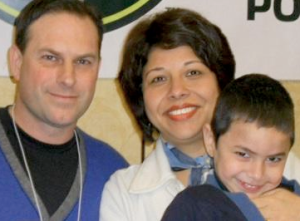
Diane Scavuzzo: What happened after college?
Stan Baker: It was difficult – there were no stepping stones to pro soccer like there are today. It was hard for me as I couldn’t really dedicate the time to becoming a player anymore. I had to find a job.
I left the game for a few years and it was not until the 94 World Cup that I became interested in coaching.
Diane Scavuzzo: What is the biggest mistake made most often by youth coaches today?
Stan Baker: According to coaching mentor Horst Wein, soccer starts in the head (perception and decision making), flows through the heart (the passion for the game) and ends in the feet (the execution of the technique).
We have placed so much emphasis on the feet (technical execution) we have forgotten the areas of perception and decision making – which is where everything begins.
Diane Scavuzzo: What do you see on the training field that bothers you?
Stan Baker: I frequently observe players and teams warming up without a ball. This rarely happens in countries such as Argentina, Brazil or Spain. Players enjoy themselves much more when a ball is present.
In America, many of our players spend too much time without a soccer ball and without making decisions.
Coaches tend to do more analytical training. An example of such training would be dribbling through cones. While it trains technique, there is no improvement in decision making or perception. A better option would be to have low numbers such as a 3v3 game where the players must dribble over an end line to score. In the book I use a quote from Real Madrid coach Jose Mourinho to illustrate this difference that says “A great pianist doesn’t run around the piano or do pushups with the tops of his fingers. To be great he plays the piano”
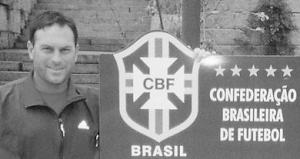
If you put players into a global environment, which is similar to the game – time, space, opponents, teammates, ball; you can train technique at the same time as you are training perception and decision-making.
The trick is coaches need to keep the player to ball ratio number low. The younger the players, the lower the ratio should be.
When coaches are just doing technical training, the players work only the left hemisphere (non creative side) of the brain and there is no room for creativity.
Most training sessions should be related to the game. Specifically, I mean 85-90% should be global in nature.
Futsal is another great tool for player development which more players should participate in. Many of the great soccer players played futsal.
We need to do more than we have done before.
We can’t just count on our kids showing up and being technically ready – we have to light our players’ fire and encourage them to enjoy practicing with the ball on their own. Those who grow up in a soccer culture often spend vastly more amount of time with the soccer ball on their own. We do have many of these players in the United States.
Diane Scavuzzo: How can coaches persuade players to practice on their own?
Stan Baker: This is something that coaches can model in their training sessions, for example consistent juggling and competitions in the warm up, and the watching of you tube videos to learn new tricks.
The youth soccer club can be a strong driving force encouraging players to practice on their own.
Diane Scavuzzo: How can clubs promote individual player development?
Stan Baker: Every coach is going to have their own way of delivery and their own style of coaching, but educating our coaches to understand what is involved in creating the proper environment for development is the first step.
Perhaps even seeing that education is important is the very first step.
Clubs can encourage coaching education.
Clubs can also help by allowing time for free play and making it clear that the club is about development and not only about winning.
When a club makes it clear that their decisions are based upon what’s best for the players – development over a win-now philosophy, players will improve.
And this is hard. Some people are less open to change as they feel they are judged on their winning records. I feel many coaches fear they may lose their job if they do not win. Winning in the immediate future is much easier than long-term player development.
Diane Scavuzzo: What does player development look like in place of the emphasis being placed on winning?
Stan Baker: All players should be challenged to make decisions as to when and where to dribble or pass the ball while being highly involved in the play. Development is not happening when the team relies on only two or three players while the rest are not involved in the play.
I think we have trouble now that we have so many good players on the fields today. I think our coaching education has lagged behind. When I watch high-level youth soccer training sessions, I see that we have players that are technical, but I do not see decision-making happening…and this change should start at the top and come from the club directors.
Diane Scavuzzo: Why is there such a resistance to change?
Stan Baker: Many Directors of Coaching are often comfortable. Some could be unwilling to go out of their way to learn new ideas, many could be simply unsure of how to embrace these changes.
We need soccer players who are more comfortable with the ball and cognitively able to deal with the speed of the modern game.
Diane Scavuzzo: If we changed youth training to reflect this intelligent type of soccer player development, could we play better American Soccer players on the world stage?
Stan Baker: Yes, definitely, and we could create our own soccer culture.
Diane Scavuzzo: Does America have its own soccer culture or identity?
Stan Baker: We have many soccer cultures and identities. One of the reasons I wrote the book was to support the curriculum put out by U.S. Soccer and to hopefully get more coaches, parents and players on the same page. I wanted to share ideas with coaches to help improve the overall training environment.
Diane Scavuzzo: And advance the game in the United States?
Stan Baker: Yes. The coaching revolution starts with education, getting the correct progressions and putting our players in global environments during the formative stage from 8-14 years of age.
Diane Scavuzzo: It sounds like you have done a lot of research on youth player development.
Stan Baker: I have a whole room, a huge library dedicated to books, articles DVDs on soccer and the majority of the information is recent and comes from Spain, Argentina and Brazil, and it is all in Spanish. I wanted to make this information available to the youth soccer coaches in the USA.
Diane Scavuzzo: What advice would you give to DOC’s (Directors of Coaching) when they try to implement the player development aspect of curricula and are met with the win at all costs mentality by board members or even families?
Stan Baker: It all comes down to education. It is important to get the parents together and give them evidence on what the player development model looks like and why it should come first. Playing kick-and-rush style soccer wins games immediately, but doesn’t lead to successful long-term player development.
So many parents see themselves through their children, and they want to see results and be able to brag about the wins, and in our fast paced culture we don’t tend to like to be patient in order to see longer term results.
Diane Scavuzzo: These parents were probably not successful athletes and do not understand the importance of long-term player development instead of a big win over the weekend. Patience needs to be encouraged.
When she knew I was going to be talking to you, SoccerNation News Columnists Dr Dina Gentile wanted me to ask how much the U.S. Women’s National Team’s success plays in the development of girls’ soccer in the nation. Do you think girls actually have an advantage over boys in terms of development for any particular reasons? Do girls learn more about possession and team play over their years of development more than their male counterparts because the outcome of sport for males may be driven by wins over performance at the earliest of ages?
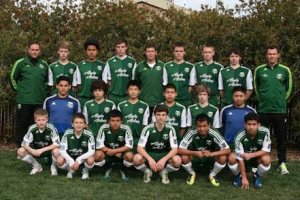
Stan Baker: One thing that is missing for the development of young girl soccer players is watching role models play professional games. Obviously it is hard – the best environment would be to see professional women playing and the next best thing would be to watch more men’s games in person or on television.
Diane Scavuzzo: A lot of experts have said that youth players should watch the professionals play soccer. What are your favorite teams?
Stan Baker: I have been an Atletico Madrid fan since ‘86, but Barcelona is no doubt the best pro team to watch.
Diane Scavuzzo: Back to the difference between girls and boys – is there a difference in player development?
Stan Baker: Girls tend to be more interested in “why” we are doing something. This is a natural advantage.
Diane Scavuzzo: So girls can have an advantage? I hate stereotypes but…
Stan Baker: Boys often just want to go and play, and a girl’s cerebral focus can be an advantage. Also, the team environment is more important for the girls. Girls tend to place the emphasis on team first and they really want to learn the whys and are more open to a dialogue.
Diane Scavuzzo: What is one simple thing coaches can do better?
Stan Baker: A big piece of the puzzle is the way we deliver information to the players. Coaches should use an open-ended conversation and get players to think, make decisions, and to be more perceptive. Constantly telling players what to do does not develop them cognitively.
Diane Scavuzzo: What can parents do better?
Stan Baker: Parents are so very important. They should learn more about the game, especially if they did not grow up playing or watching a lot of soccer.
Diane Scavuzzo: What are you working on with your Pre-Academy 2000 Portland Timbers’ team?
Stan Baker: To flourish in the academy system, players need a high comfort level on the ball along with good decision making in tight spaces. Good players need to know what to do on and off the ball within an ever changing game environment.
There are a lot little things, less tactics up to age 14 and more important concepts. Some of these concepts may include angle of support, body position, looking over the shoulder, moving away after a pass, proper speed on the pass, disguising intent etc…
I think that if we can combine the strengths found within the different soccer cultures found here in the United States while being open to change and new ideas, that we can create the American soccer of the future.
Stan Baker’s book Our Competition is the World is available on AMAZON.



